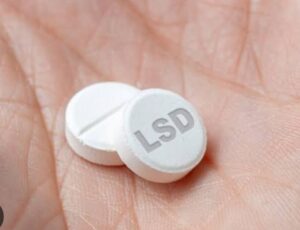What Does LSD Look Like
LSD (also known as acid) is most commonly encountered in the form of tabs, liquid, and pills. LSD can take many different forms. It was initially created as a white, crystalline powder. However, in that state, it is typically not utilized or sold.
- Tabs: These are small squares of absorbent blotter paper, typically 1/4-inch, each delivering one dose, usually between 100 and 350 micrograms (μg). To allow LSD to reach the bloodstream, blotter paper tabs are placed in the mouth and held on or beneath the tongue for three to fifteen minutes. Instead, they chew the tabs for a few minutes.

- Liquid: In small bottles which the dosage is written on. A colorless liquid in a small dropper bottle

- Pills: It’s rare to see LSD in this form which is easy to take just like tabs which have a higher risk since it’s deal with digestion of the stomach or intestine walls

Saving Someone From LSD Bad Trip
Bad trips can be emotionally taxing due to the long-lasting effects of LSD. Some users say that having a horrible vacation is one of the worst things they have ever experienced. Confusion, disorientation, panic attacks, paranoia, and even psychosis can occur in people. They might behave in risky, illogical, or even self-destructive ways, or they might feel isolated or trapped.
Here are Hellotripsitters guidelines to help you from bad trip
- Tell them they are secure and that whatever they are going through is okay as you approach them with love and care. Ask them to talk about their experiences.
- Take the person to a secure location that is peaceful, quiet, and cozy; keep them away from dangers and sensory input sources like crowds, loud music, and bright lights.
- Cover the person with blankets and have water beside you
- Call a doctor after this 1st aid you carried
- Stay with the person while having a conversation
Effect Of LSD Drugs
Everybody can be affected by LSD in a different way depending on their size, weight, health, and the amount and potency of the drug.
- Euphoria and wellbeing
- Dilation of pupils
- Visual and auditory hallucinations
- Less concentrating
- Headaches
- Nausea
- Fast heartbeat
- High body temperature
- Tremors
- Dissociation
- Depression
- Anxiety
- Breathing
- Vomiting
- Sweating, and chills
- Panic
- Seizure
- Chest pain
- Psychosis
LSD Trip
The term “LSD trip” describes the changed perceptions and state of consciousness brought on by LSD (lysergic acid diethylamide) use. Changes in thought patterns, emotional intensity, and distortions of sensory perception are all hallmarks of this psychedelic experience. LSD is used to treat anxiety, psychosomatic diseases, and depression since a single dose may alter a person’s cognitive processes.
Neither plants nor fungi naturally produce LSD. It is a synthetic drug, more precisely a derivative of lysergic acid, which is a naturally occurring substance present in some fungi, such as ergot. LSD has a half-life of between three and 5.1 hours.
